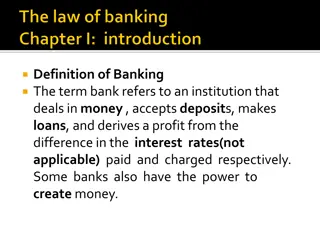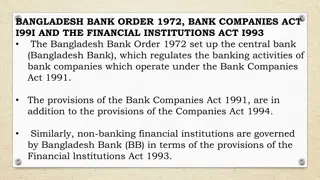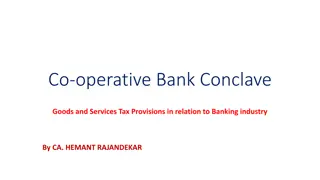Narasimham Committee and Indian Banking Reforms
Narasimham Committee, established in 1991 and 1998, played a pivotal role in restructuring the Indian banking sector. The committees, headed by Shri M. Narasimham, addressed issues like low economic growth, non-performing assets, unsatisfactory customer service, and outdated banking systems. They introduced the concept of Non-Performing Assets (NPAs) and recommended reforms for the stability and efficiency of financial institutions. The recommendations focused on asset classification, provisioning, income recognition policies, and international standards compliance.
Download Presentation

Please find below an Image/Link to download the presentation.
The content on the website is provided AS IS for your information and personal use only. It may not be sold, licensed, or shared on other websites without obtaining consent from the author. Download presentation by click this link. If you encounter any issues during the download, it is possible that the publisher has removed the file from their server.
E N D
Presentation Transcript
Need of Narasimham Committee - I Efficient banking structure can promote for greater amount of investment. Investment can help to achieve a faster growth of the economy. In 1991, India made drastic changes in the economic policy by adopting Liberalization, privatization, globalization. India was facing macro economic crisis 1) The economy was growing at very low rate. 2) There were high non performing assets. 3) The customer service was unsatisfactory.
Need of Narasimham Committee - I 4) Banking system was not sound enough. 5) Poor financial condition of commercial banks. 6) The banks were lagging behind international standards in terms of computer technology, accounting standards and capital adequacy, etc. Government of India appointed a high level committee headed by Shri M. Narsasimham, a former governor of the Reserve Bank of India. Government of India set up two committees.
Narasimham Committee Narasimham Committee First - 1991 Second - 1998 1) Narsasimham committee on financial sector reform in 1991. 2) Narsasimham committee on banking sector reform in 1998.
Introduction The first Narasimhan Committee (Committee on the Financial System CFS) was appointed by Manmohan Singh as India's Finance Minister on 14 August 1991. The committee submitted a summary report to the government of India on November 8, 1991 and the main report on November 16, 1991. The report was accepted by the Government of India in the year 1992.
Introduction The concept of Non-Performing Assets (NPAs) was introduced for the first time in the Narasimham Committee-I report, which was submitted to the Finance Minister in the month of November 1991. The committee studied the existing financial system, identified its shortcomings and weaknesses and made various recommendations in order to make it more stable.
Introduction One of the recommendations was with regard to non- performing assets, their identification, disclosure and the extent of provisioning for the same. A need was felt because the prevalent accounting and disclosure practices did not always reflect the true state of affairs of banks and financial institutions. The Narasimham Committee examined the issues and recommended that a policy of income recognition should be objective and based on recovery than on any subjective considerations.
Introduction The committee recommended that provisions should be on the basis of foursome (group of four) classification of assets into standard, sub- standard, doubtful and loss categories. In April, 1992, the RBI decided to implement this recommendation. Due to the implementation of the prudential norms (guidelines and general norms issued by the regulating bank i.e. RBI) the accrualconcept has been changed into recoverabilityconcept in recognizing the income on non-performing assets.
Introduction A uniform practice has been adopted in respect of provision to be made on Non-performing Assets (NPAs).
Definition of NPA 1) Non Performing Asset means an asset or account of borrower, which has been classified by a bank or financial institution as sub-standard, doubtful or loss asset, in accordance with the directions or guidelines relating to asset classification issued by the Reserve Bank of India . 2) A NPA is defined as a credit facility in respect of which the interest and / or installment of principal has remain past due for a specified period of time .
Definition of NPA 3) An asset including a leased asset becomes non- performing when it ceases to generate income for the bank RBI. 4) NPA means those assets / credits / debts from which does not get any income as interest for last / exceeding 90 days at the balance sheet date .

















































